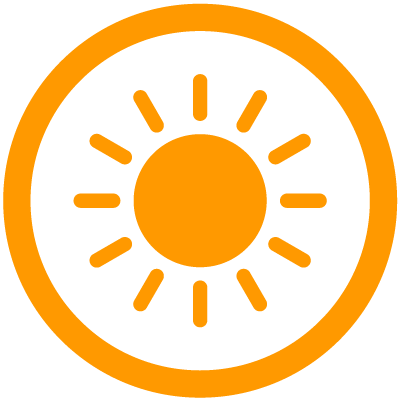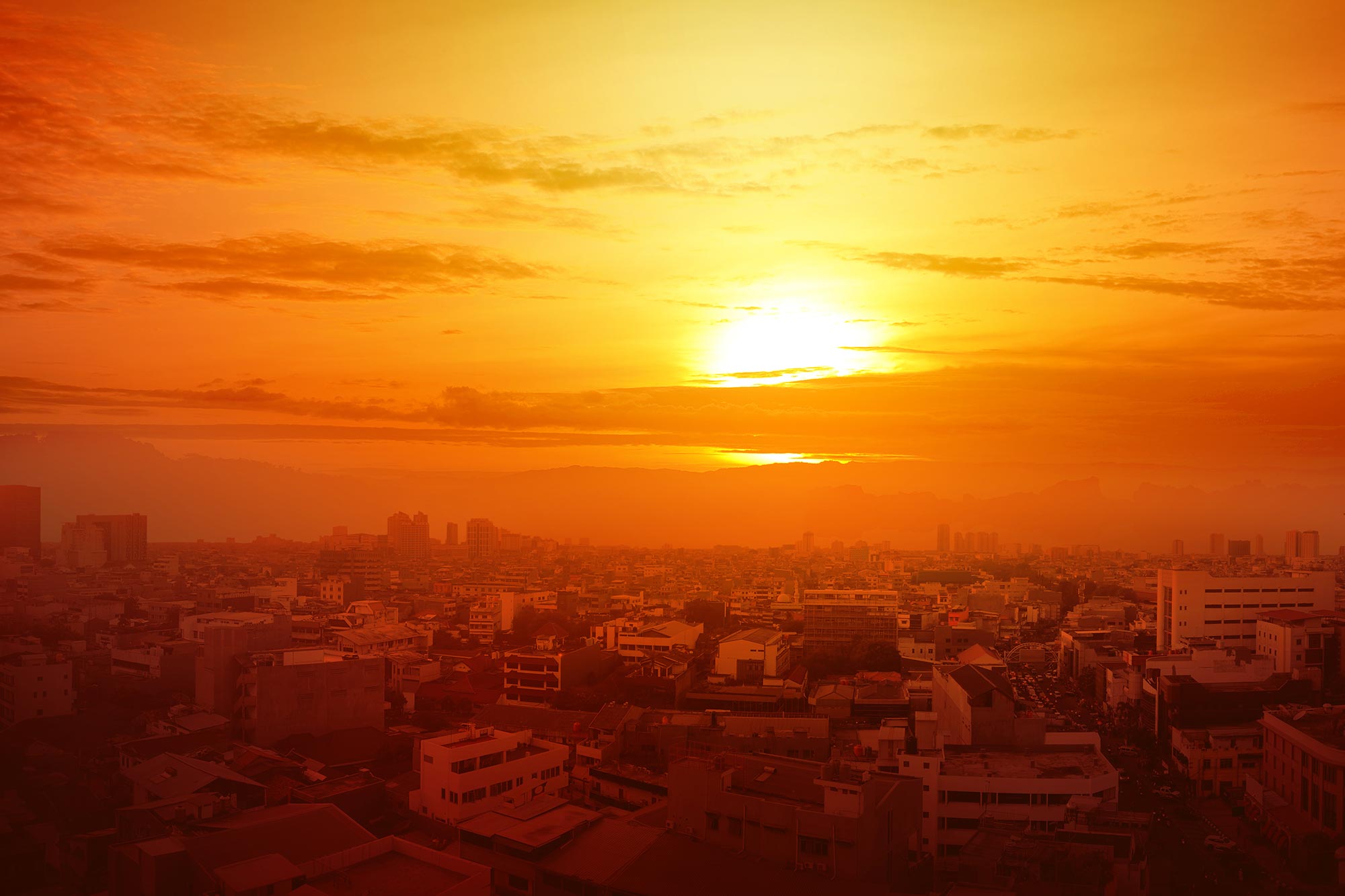
Heat
The Earth is getting hotter due to human activities that release heat-trapping gases into the atmosphere. This human-caused global warming is undisputed in the scientific literature, and numerous studies have identified the human fingerprint on recent extreme heat events.

How has climate change already worsened US heat waves?
Climate change currently causes rare heat waves to be 3 to 5°F warmer over most of the United States. By 2050, U.S. heat waves could be an extra 3 to 5°F warmer.
It is virtually certain that the Northern Hemisphere heat waves in Summer 2018 could not have occurred without climate change. Moreover, observed climate change has exposed an extra 16 percent of the populated and agricultural areas in the Northern Hemisphere to extreme heat waves.[1]
Human-induced climate change contributed to the record breaking global hot temperatures in 2014, 2015, and 2016. The 2016 temperatures had a 27 percent chance of being record-breaking, but without climate change, that chance would have been one-in-a-million.[2]
For the 2000-2009 decade, climate change quadrupled the likelihood of a record-breaking hot year for all of the US.[3]
Climate change has at least doubled the likelihood of record-breaking hot summer days in the US.[4]
Climate change is increasing heat stress, a dangerous threat to human health. Nighttime temperatures are increasing faster than daytime, making it harder for the human body to cool down at night.[5][6]
What is a heat wave?
A heat wave is generally understood to be a period of extreme warmth, though there is no single, standard definition of a heat wave. The World Health Organization defines heat waves as, "A marked [period of] unusual hot weather (Max, Min and daily average) over a region persisting at least two consecutive days." To be considered a heat wave, the temperatures have to be outside the historical averages for a given area.
How does climate change worsen heat waves?
The clearest and most direct effect of human-driven climate change is the increase in global temperatures. We have already observed a rise of 1 degree Celsius (1.8 degrees Fahrenheit) in global average temperatures. Heat waves have always affected societies, long before human-driven climate change. However, when a ‘wave’ of hot temperatures occur in an already 1-degree-warmer world, they are more likely to be pronounced heat waves. Thus, climate change has increased the probability that a heat wave will be severe and has increased the frequency of heat waves and record-breaking seasons and years.
Climate change is also altering atmospheric circulation (e.g. the jet stream), and some of these changes are dramatically amplifying local heat extremes.[2] For instance, the jet stream is increasingly going off its traditional course and sometimes stalls altogether. When it stalls, high pressure ridges get ‘stuck’, leading to longer and more intense heat waves.

Regional Spotlight
The earth is not warming evenly - certain places, seasons, and even times of day are warming faster than others. In fact, the east-west pattern of freezing east coast weather happening at the same time as hot California winters is likely due to climate change - climate change has led to more frequent warm winters in the Western US while the Eastern US experiences cold winters.[9]
Western US

- In the Western US, half of all record breaking heat waves would not have been record-breaking without climate change.[10]
- In summer, heat waves are now five times more likely to occur due to climate change.[11] We can see these effects in recent heat waves - the combination of human-induced climate change and natural variability made the 2013 US Southwest heat wave significantly more likely.[12]

Central US
- Climate change has been detected in record-breaking hot seasons and years as early as the mid-1990’s.[13]
- These effects have been muted, however, by the presence of the ‘warming hole’.[14] The ‘warming hole’ is an area extending across the south-central US which has warmed more slowly than the rest of the US, and in some cases even cooled; however, it is mostly due to natural variability and local pollutants, and is not evidence of a ‘hiatus’ in global climate change.
- The 2011 Texas heat wave occurred in a region partially overlapping with the ‘warming hole.’ While 80 percent of the direct contribution to the heat wave was natural variability, 20 percent was due to climate change.[15] Moreover, the extreme temperatures were made ten times more likely by climate change.[16][17]

Eastern US
- Climate change has made extreme heat events at least three times more likely in winter and at least five times more likely in summer.[11]
- Climate change has quadrupled the frequency of events like the 2012 hot summer over the North-Central and Northeastern US and increased the likelihood of the 2012 Eastern US March-May heat event by a factor of 12.[18][19]
- In the Eastern US, one-out-of-every-ten record breaking heat waves would not have been record-breaking without climate change.[10]

Alaska
- Alaska has warmed more than any other state.
- Hot winters and summers in Alaska are now five times more likely to occur due to climate change.[11]
- Record breaking heat in the Arctic during winter 2016 would not have been possible without climate change.[20]
- Record Arctic heat in 2016 led to an unprecedented marine heat wave off the coast of Alaska that decimated marine ecosystems. The marine heat wave likely could not have occurred without climate change.[21] According to one study, climate change made it up to 50 times more likely to occur.[22]

The social impacts of climate change and worsening heat waves in the US
America’s legacy of racism, economic exploitation, and environmental injustice intersects with climate change to compound harm to poor communities, indigenous communities, and other communities of color.
Neighborhoods with higher temperatures due to more pavement and fewer trees are often the ones historically subjected to discriminatory, race-based housing practices. In the 1930s, the federal government rated neighborhoods in urban areas to help mortgage lenders assess risk. Low ratings were determined largely by race and ethnicity. Today, those redlined neighborhoods are often hotter than other neighborhoods in the same city. In a study of 108 urban areas nationwide, the formerly redlined neighborhoods of nearly every city studied were hotter than the non-redlined neighborhoods. Portland and Denver had the most drastic differences in surface temperatures (over 12°F) between redlined and higher-rated neighborhoods.
Studies that specifically address the issue of race as a risk factor for heat-related illness and death are limited, but available studies tell the same story: certain communities of color in North America are disproportionately harmed by extreme heat. For the period 2004-2018, Indigenous communities had the highest rate of heat-related deaths and Black communities had the second-highest.[1] During the 1995 Chicago heat wave, Black people were disproportionately represented in the heat statistics and were 1.5 times more likely to die than White people.
Societal vulnerability is a major factor in the determination of who experiences the most severe impacts of extreme heat, with access to cooling being one of the most important factors in determining household-level adaptive capacity.
"If it’s going to be too hot to work outside, we know who’s going to be affected. If we’re talking about urban heat islands, we know who can’t afford to run their air-conditioners 24/7. Climate change is more than parts per million and greenhouse gases. The people who are feeling the worst impacts of climate, their voices have got to be heard."
Dr. Robert Bullard
Sign Up to Receive Heat Waves Thought Leadership
Form temporarily disabled.









